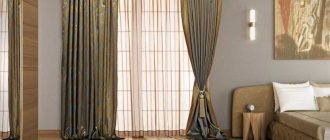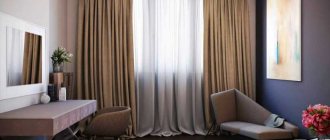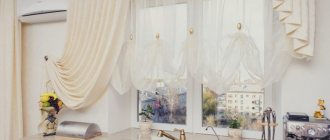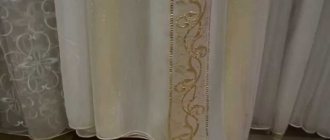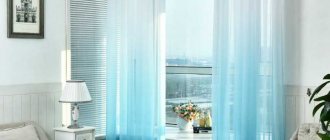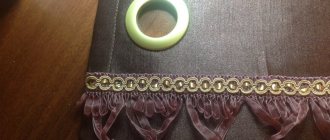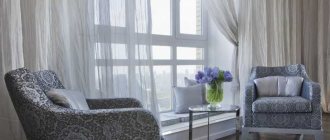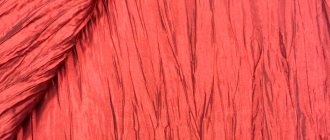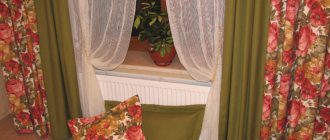Historical reference
It is believed that the thin, weightless fabric that hides your home from prying eyes owes its origin to the bride of the French king. According to legend, the girl was so embarrassed by the looks of numerous onlookers at the upcoming wedding that she asked the king to order a fabric for the veil so that it would hide the girl from prying eyes, but the bride herself could clearly see everything around her.
The king fulfilled his wish, the weavers came up with the fabric that we know as tulle. The court liked the fabric so much that they began ordering window curtains from the new fabric. At the French court, the fashion was picked up in other countries. Modern tulle is made from other materials, but the meaning remains the same.
How to choose tulle
Tulle is one of the most beautiful types of textiles. This fabric is always pleasant to hold in your hands, as it is airy and almost weightless. Manufacturers of wedding dresses have long loved her. Today, this fabric can be seen not only in clothes for brides, but also on various skirts, carnival costumes and curtains. This article will tell you about all the benefits of tulle and what is made from it.
What's special about tulle
Compared to other materials, tulle, despite its lightness and tenderness, is a fairly durable fabric. It holds its shape perfectly and is well suited for creating all kinds of folds and flounces. That is why they love to use it in clothes for any holidays. It is also worth noting that tulle can be dyed. In the interior or in any outfits, the color of this material can be absolutely any. Tulle also has different cell sizes. This allows designers to create outfits of unprecedented beauty, since the stiffness of the fabric also depends on the cell size.
Advantages
From all of the above, you can already understand what advantages this fabric has. All that remains to be added is that tulle, like no other material, produces truly magical outfits that, despite their apparent bulkiness, are light in weight. This material is also used to make incredibly beautiful and sophisticated curtains, which you can look at by following the link: https://lanita-shtor.com.ua/category/fatin/. They allow air to pass through well, which is a big plus. Also, the fabric dries very quickly after washing, and tulle curtains can also be ironed.
Turkish tulle curtains
According to most people, curtains made in Turkey are of much higher quality. Such curtains look very beautiful and expensive. Over time, the Turkish tulle will not lose its superiority. Curtains made from material created in this country also have a variety of designs and will fit perfectly into the interior of a small apartment, as well as a luxurious and large country house. You can choose options for any room. For example, curtains with a large pattern are suitable for a hall or living room. Delicate and thin curtains without a pattern will be the best solution for the bedroom.
Conclusion
When choosing tulle products, there is no doubt that this is the right choice. Light and beautiful fabric will be an ideal gift for people with ideal taste.
Elena,
Functional load
Tulle is widely used to create curtains due to its ability to transmit light and air well. Beautiful tulle in the bedroom will not only hide you from prying eyes, but will also add lightness to the interior. In addition, tulle can hide the imperfections of a window opening and visually align the geometry of the room.
If your bedroom has a lot of reflective surfaces, the light passing through the patterned tulle will create beautiful patterns. This will bring some zest to your bedroom.
Tulle
Tulle tulle for the bedroom 2021 is an original option. This material is mesh, and the threads in it are tightly intertwined. In some ways the texture resembles a honeycomb.
This fabric produces rigid curtains, which are distinguished at the same time by their splendor and lightness, as well as their unique appearance.
Materials
Now there are many variations of tulle made from artificial and mixed fabrics. Let's look at the most popular of them.
Tulle is a light, translucent, but quite rigid material. It is more suitable as an additional layer for a softer and more delicate tulle.
Viscose is an artificial fabric. It is distinguished by its lightness, variety and fragility. This disadvantage is compensated by the low price of the material.
The veil is made from cotton threads that are tightly intertwined. Very soft and lightweight fabric. It allows air to pass through well, but due to its natural origin it gets very dusty and requires frequent washing.
Organza is best suited for making curtains. Despite its transparency, it is a very durable fabric. Organza can be made from natural silk threads, polyester or viscose; the cost of the product depends on the threads.
Crepe
Crepe is a worthy alternative to veil and chiffon. This is a translucent, soft and matte fabric that drapes perfectly, creating soft, elegant folds. For its production, threads with a large (crepe) twist are used in a certain alternation (crepe weave), which form a rough, fine-grained surface of the fabric.
The advantages of crepe also include low creasing, high wear resistance and ease of care, which, of course, depends on the raw materials used for its production. Depending on the composition, there are silk, semi-silk and cotton crepes, crepes made from artificial (viscose) and synthetic threads (polyester, nylon, nylon).
Criterias of choice
When choosing which tulle is best for the bedroom, consider first of all the shape of the window opening. It’s worth considering whether you want to cover only the window or the partitions near the window block with tulle.
Next, you should choose the color and design of the tulle for the bedroom. They should resonate with the design of the room.
If you often wash curtains and tulle, choose curtains made from artificial fabrics. Polyester and viscose tulle withstands frequent washing best.
Lightness from white classics
This solution will be universal and appropriate in any room design style. Transparent white curtains without patterns.
They are characterized by an excellent combination with various curtain options, which will complement the sleeping room favorably. Often, white tulle in the bedroom is included in the basis of Japanese or Roman curtains.
Wash
In order for your new tulle to last a long time, you need to care for it in the following order:
- Carefully shake off the dust from the tulle; it is better to do this outside.
- Before washing, soak the tulle in a baking soda solution for several hours, this will help preserve the color of the product.
- Wash tulle on the “delicate” cycle with an appropriate detergent.
- Never twist the tulle. After washing, you need to wring it out lightly and wait until the water drains.
- You need to rinse the tulle several times, the water should be warm.
- Some types of tulle look better after starching. To make the tulle shine, add a tablespoon of vinegar to the water while rinsing.
- You can iron tulle only in the “delicate” mode. It is better not to iron it at all, but to hang it on the window in a slightly damp state.
How to determine tulle size
In order for the tulle to fall beautifully from the cornice in folds, you need to buy fabric twice as large as the width of your cornice. Depending on the style of the bedroom, it can be a short tulle in the bedroom, up to the window sill, not reaching the floor by 2-3 cm, or reaching the floor.
When choosing a size, you should follow the rules:
- There should be at least five centimeters left on the sides of the fabric for hems.
- If the width of the fabric does not suit you, buy two pieces of fabric and sew them together, the seam between the folds will not be visible.
- If your bedroom has two windows next to each other, it makes sense to hang one tulle in front of both. This technique allows you to visually enlarge the room.
- The length of the future tulle for the bedroom window is measured only after the cornice is installed.
- If you choose patterned curtains, take the fabric a little wider. This will allow the ornament to be evenly distributed.
Fatin
Tulle is a transparent mesh fabric that is often used to create voluminous compositions. For its production, nylon or polyester is used. Depending on the thickness and processing method of nylon fibers, it is classified according to the degree of rigidity:
- hard tulle;
- tulle of medium hardness;
- soft tulle (Euro mesh).
Soft tulle or medium hard tulle is used as tulle. The assortment of tulle is represented by samples of different types and properties: matte and shiny, transparent and translucent, plain and tulle tulle with embroidery, large and fine mesh. There are several features of using tulle in window decoration:
- When calculating the required footage of fabric, you should take into account the fact that tulle tulle looks good only when it is gathered into numerous voluminous folds;
- The bright and extraordinary appearance of tulle tulle itself, in most cases, does not require the addition of curtains; If you nevertheless decide to complement the ensemble with another type of curtains, preference should be given to light, flowing fabrics that will emphasize the lightness and airiness of the composition.
- High-quality tulle is not prone to forming snags, but it is still undesirable to decorate the windows of rooms with access to the balcony with it.
Color solution
The color of tulle plays a very important role in the bedroom. In addition to the general appearance of the room, it must maintain the correct psychological mood of the owners of the bedroom. After all, people spend at least eight hours a day in this room. The color scheme also affects the visual perception of the space of the room.
White tulle in the bedroom is almost a win-win option. The only case where it may be inappropriate is a completely white room. If all the furniture and walls of the bedroom are painted white, then together with white tulle the room will turn into something like a hospital ward.
Green tulle is not often found in bedrooms, but if it is light tulle combined with heavy curtains of a related shade, it will successfully highlight both fabrics.
The blue color greatly decorates the room only if there are warm colors in the interior too. Blue is a fairly cool color. Photos of new designs often show a combination of blue and warm shades of brown. This combination will immediately make your bedroom fashionable.
The blue color of the tulle is also balanced by the warm colors of the bedspread, pillow or furniture. Yellow and white harmonize well with blue. Together they bring to mind the sea.
To ensure that the window area does not stand out too much from the background of the room, designers advise matching curtains and tulle in the bedroom with the main pieces of furniture (sofa, bed or wardrobe).
Combination with curtains
If you search on the Internet for photos of modern tulle ideas for the bedroom in 2020, most likely you will see a combination of tulle and curtains. In modern design, only Scandinavian interior style can do without curtains.
Almost any tulle can be combined with one type of curtain or another.
- Regular curtains made of heavy fabric go well with classic tulle; they will help dim the too bright daylight.
- Short tulle goes well with Roman or Japanese curtains on the windows.
- On the double cornice you can place thin tulle and a pompous lambrequin.
Classification of kitchen textiles
Initially, tulle was used on the windows of living rooms, large living rooms and dance halls, decorating them in the form of multi-layer compositions.
A translucent panel with light folds or draperies once filled only the central part of the window opening. On the sides the tulle was framed by heavy curtains. In the horse block, tulle was not used, replacing it with light chintz curtains.
Modern tulle is a fairly practical synthetic-based fabric. It can replace complex curtain compositions if it is beautifully draped, like a photo of tulle in a modern kitchen.
Kitchen styles differ in different parameters:
- Length;
- Style;
- Attaching to the cornice;
- The method of draping panels.
Tulle is a generalized name for window textiles that transmit daylight well. Today, the concept of “tulle” includes transparent curtains made of chiffon and nylon, tulle and organza, thread veil and voile, “gossamer” and fine “mesh”.
The listed fabrics may vary in density, texture and shade, but they are united by property (transmitting light) and functionality (design of a window opening).
Bedroom without curtains
If you don’t want to hang thick curtains, then the second layer on the window can also be tulle. Only the second layer should be slightly denser than the main fabric. The tulle in a bedroom without curtains should be a little thicker than usual to shade the light a little if your bedroom faces the south side of the house:
- Curtains made of thick artificial tulle look great, hung on grommets (through iron rings).
- From fabric of the same density as the main tulle, you can make a weightless lambrequin.
- The romantic spirit of the bedroom will come with beautiful tiebacks, decorative cords and braid.
- Thread tulles on top of classic ones look original.
- You can hang two tulles of the same quality, but in contrasting shades.
- If you have a large bedroom, tulle with photo printing is acceptable.
Modernization of classic styles
Short curtains will look great if you combine beautiful fabric and classic tailoring. Thoughtful design of a short curtain does not require a complex composition of the window opening.
Classic styles suitable for short tulle:
- Japanese screened curtains made of transparent fabrics;
- Roman and Austrian curtains;
- A short arch up to the window sill;
- Awning curtain with wavy tails;
- Double tulle of different shades with an oblique cut.
Universal styles never go out of fashion, so you should give them preference. You can find them in catalogs, sew them yourself, or order them from any curtain design studio.
If you have any doubts about how to correctly decorate a window with tulle in a kitchen with a balcony door, find an original solution for a spacious kitchen-dining room, or update the design of a small kitchen with a narrow window, see photo examples in our selection.
How to create beautiful folds
In order for the tulle not to look like gauze, it must have many uniform folds.
The easiest way to make beautiful drapery is curtain tapes. A special ribbon is sewn to the top of the tulle using two lines. Then special cords inside the tape are pulled together, forming beautiful folds that will not fall apart.
If you need wide, uniform pleats, such as for a second layer to replace curtains, choose tulle with built-in metal rings. A metal or wooden round cornice is threaded through them.
Tulle for Provence style
The Provence style has been on the list of the most popular styles for many years. Therefore, among the fashionable tulles of 2021 you can find curtains in this style.
Floral motifs add signature charm. They can be reflected in the color of the tulle; it can be in delicate shades of pink, blue or milky colors, or in a colored floral pattern on a white background. As part of the style, tulles made from natural fabrics without synthetic shine are used.
Tulle in a modern interior
Modern style has incorporated features from almost every other style. Therefore, when choosing tulle for a modern-style bedroom, you have a wide choice of colors and styles.
In addition to the classic options in different colors, Roman blinds made not from linen, but from tulle, look good in such interiors. They cover the windows from prying eyes and unusually frame this area of the bedroom.
Thanks to a wide selection of fabrics in specialized stores, any owner will be able to choose natural and synthetic tulle to suit their taste and budget.
Choosing material for tulle
Beautiful tulle in the interior of the hall depends on the material from which it is made. Typically, consumers make a choice among mesh fabrics, organza and voile. Such materials can be transparent, matte, patterned, lace.
Veil
This fabric is softer than organza, comes in different densities and is available in a wide range of colors. The veil gets dirty less often and can be washed less often. It lends itself well to draping and drawing.
Organza
Organza tulle has its pros and cons. It looks airy, refracts light well, but practically does not allow air to pass through due to its synthetic structure. But it is easy to wash, and organza dries almost instantly.
Net
Consumers are increasingly turning their attention to mesh tulle. It looks so good in the interior that it practically does not need additional decoration. At the same time, it transmits light well into the room.
True, there is one “but” - synthetic fabric attracts dust like a magnet, so window mesh is contraindicated for allergy sufferers.
How to diversify your home interior: DIY decor and beautiful design ideas- How to hang curtains - step-by-step instructions with photo examples and recommendations. Exclusive curtain design solutions from experienced craftswomen
- Curtain tiebacks - 150 photos of new exclusive designs
Chiffon
It looks respectable on windows, because it has a relief structure formed by the interweaving of crepe threads. But sewing curtains is difficult, because the material frays a lot, and such tulle does not hang on the windows for long, and it will have to be changed again.

